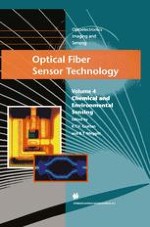Environmental and chemical sensors in optical fiber sensor technology The nature of the environment in which we live and work, and the precarious state of many aspects of the natural environment, has been a major lesson for scientists over the last few decades. Public awareness of the issues involved is high, and often coupled with a scepticism of the ability of the scientist and engineer to provide an adequate, or even rapid solution to the preservation of the environment before further damage is done, and to achieve this with a mini mum of expenditure. Monitoring of the various aspects of the environment, whether it be external or internal to ourselves and involving chemical, physical or biomedical parameters is an essential process for the well-being of mankind and of the individual. Legis lative requirements set new standards for measurement and control all around us, which must be met by the most appropriate of the technologies available, commensurate with the costs involved. Optical fiber sensor technology has a major part to play in this process, both to complement existing technologies and to promote new solutions to difficult measurement issues. The developments in new sources and detectors covering wider ranges of the electromagnetic spectrum, with higher sensitivity, allow the use of techniques that some time ago would have been considered inappropriate or lacking in sufficient sensitivity.
